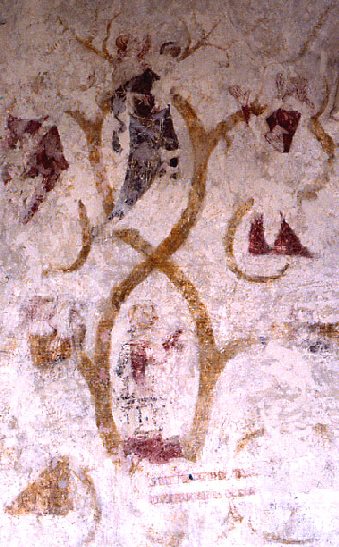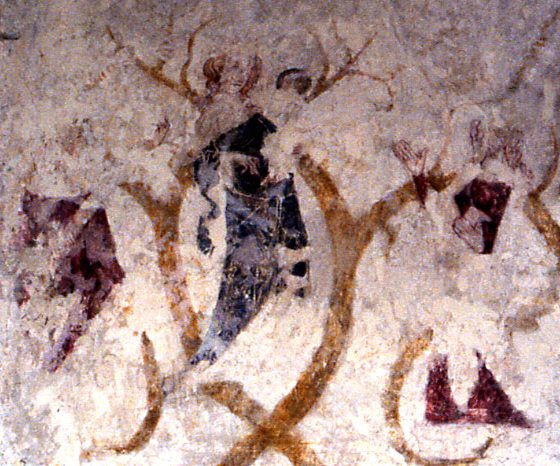Chalgrove, Oxfordshire (†Oxford) Early C.14
Tree of Jesse

As a painted subject, the Tree of Jesse demands space if it is to be intelligible, and even in the lofty chancel at Chalgrove there might not have been as much space available as the painter would have liked. Some English Trees of Jesse have or had (usually the latter) a recumbent Jesse as the root of the symbolic tree, but at Chalgrove the ancestor of Christ is instead represented by an inscription quoting, almost certainly, Isaiah 11:1 – ‘Et egredietur virga radice Jesse et flos de radice ejus ascendit’¹. The lines are sadly indecipherable now.
Above the inscription, the painter has reduced the subject to its essentials; in an almond-shaped mandorla formed by vine-stems, King David, founder of the royal house of Israel, plays a harp, although he, his harp and his throne are fragmentary now. In the vine tendrils on either side, praying figures flank him.
Directly above David is another mandorla, fortunately much clearer and shown in more detail at the right below, with the Virgin holding the infant Christ.

Stylistically, this detail is of great interest. The Virgin herself is a very beautiful figure, the draped folds of her mantle falling gracefully from the S-curve of her body. Her right hand is held at her waist, and the poised, aristocratic articulation of her long slender fingers is in very marked contrast to the much heavier and less elegant hands of the kneeling figure flanking her on the right.
This is perhaps simply a comment on Mary’s uniquely superior status, but I think that these figures might well have been painted by different artists, with the master reserving the Virgin and Child for himself, and delegating subsidiary figures to an assistant. It is possible too that the Virgin and Child are scaled-up copies of an illustration in a manuscript, where this subject is frequently found. On these points, a comparison with the Warning to Swearers at Broughton in Buckinghamshire might be illuminating.
The very existence of the Tree of Jesse as a subject in English wall painting goes some way towards explaining the apparent lack of interest among painters in the histories narrated in the Jewish Bible or Old Testament. What mattered in the Middle Ages was the culmination of these, the prophesied flower that eventually emerged from the root, with the intervening branches of much smaller importance.
There is a cluster of Trees of Jesse in this corner of England, and they and the fine example at Weston Longville in Norfolk will in due course be linked in the table below.
The chancel at Chalgrove is very fully painted, and there are some very fine paintings indeed, as well as a useful booklet with helpful drawings of them when they were first uncovered in 1858 (it is heartening to report that the then incumbent, the Reverend Robert Lawrence, ensured that the subsequent battle of wills about their preservation at Black Bourton did not take place here).² As well as the Annunciation at Chalgrove, which has been on the site for some time, the chancel paintings of the Death, Burial, Assumption and Coronation of the Virgin are also now here, and there is more information about this very important church and its paintings on that page.
¹ ‘And there shall come forth a rod out of the stem of Jesse, and a branch shall grow out of his roots…’
² The Medieval Wall Paintings of St Mary’s Church, Chalgrove, RW Heath-Whyte, 1991 (illustrated booklet available in the church)